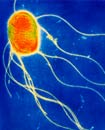Salmonella enterica: foodborne illness
The bacteria Salmonella is commonly associated with food poisoning in countries all over the world. There are two species of Salmonella: S. enterica and S. bongori. However, the species that most people refer to when they talk about Salmonella is S. enterica. This species is divided into a subset comprising of serovars. In S. enterica alone, there are over 2,000 serovars of bacteria. The most common cause of food poisoning is associated with the serovar S. Enteritidis. These outbreaks are attributed to unsanitary meat preparation that can be traced as far back to the farm where the poultry or beef were raised. Because of the high demand in the meat processing industry, farms can become highly unsanitary. For example, chicken farms contain thousands up on thousands of chickens all living in the same area. Dead chickens are left for days before they are removed from the others. If one chicken contains the Salmonella bacteria, the organism can spread rapidly through thousands of others. When these chickens are processed and sent to stores all over the country, a mass Salmonella outbreak can occur. When humans contract this disease, they can expel some of the Salmonella bacteria in their feces. In areas with poor sanitation, these bacteria can get into the water system where they can infect another person or animal and begin a whole new cycle of transmission.

Pathogenesis
Salmonella enteritidis is a rod-shaped, gram-negative, proteobacteria that is non-motile. These facultative anaerobes are well adapted to survive in condition with our without oxygen, allowing them to live in diverse environments. However, Salmonella enteritidis are usually found within animal hosts where they can be transmitted easily through food processing or fecal matter in areas with poor sanitation.
Research
something
Treatment
For those cases that require medical treatment, the most common method is through the use of antibiotics. The two most common antibiotics used to treat Salmonella enteritidis are Ampicillin and Ciprofloxacin.
Symptoms and Prevention
The most common symptoms of Salmonella enteritidis include fever, diarrhea, vomiting, abdominal cramps, muscle aches, and headache. These symptoms generally last between 4-7 days. Healthy individuals can usually rid themselves of this bacteria on their own; however, children, elderly people, and those with compromised immune systems may require treatment.
The most effective way to prevent Salmonella infections is to thoroughly cook all meats. The United States Department of Agriculture has also published guidelines to prevention. These include washing your hands and cooking surfaces often as well as washing hands, cooking utensils, and cooking surfaces with hot, soapy water before handling any food. Because red meat, poultry, and seafood are more susceptible to carrying Salmonella, they also recommend separating these foods from other food in your refrigerator. Cooking at proper temperatures and refrigeration are important steps in preventing Salmonella outbreaks.
Conclusion
Overall paper length should be 3,000 words, with at least 3 figures.
References
Edited by student of Joan Slonczewski for BIOL 238 Microbiology, 2009, Kenyon College.
